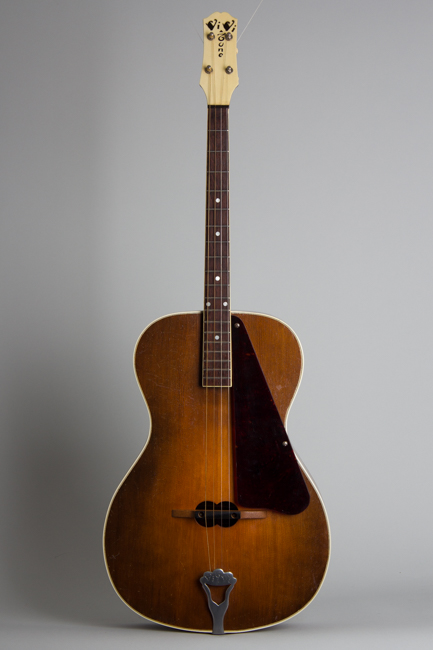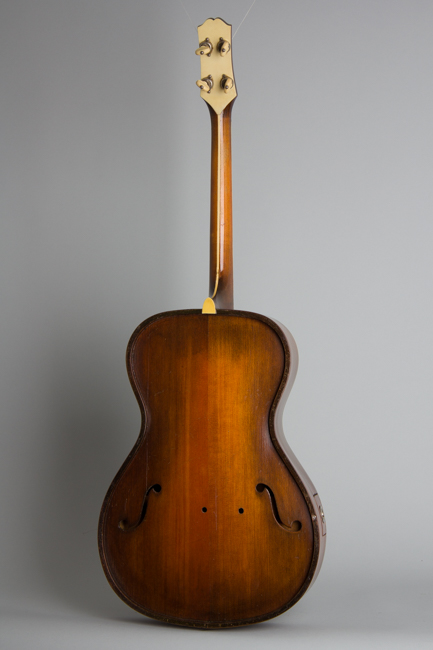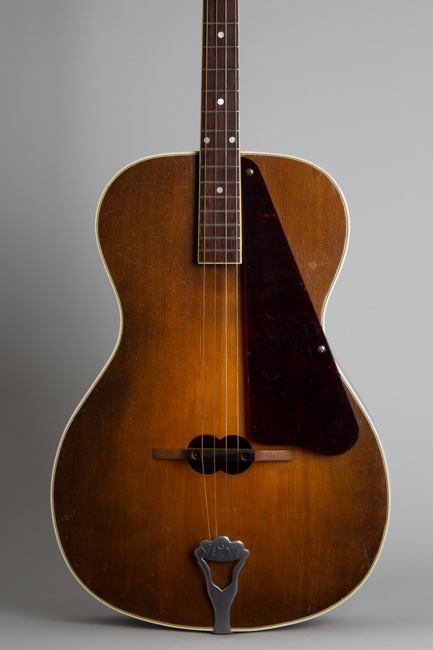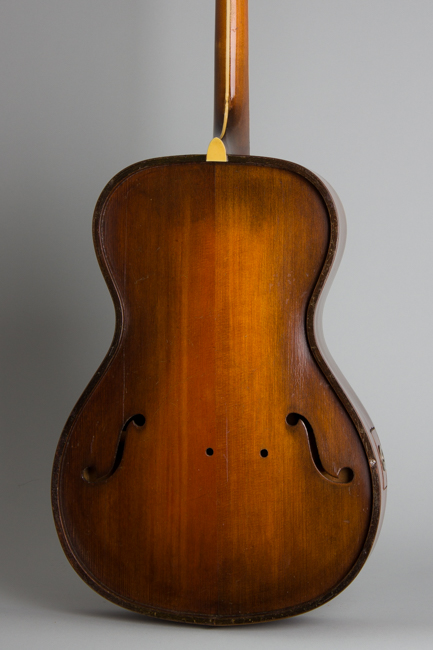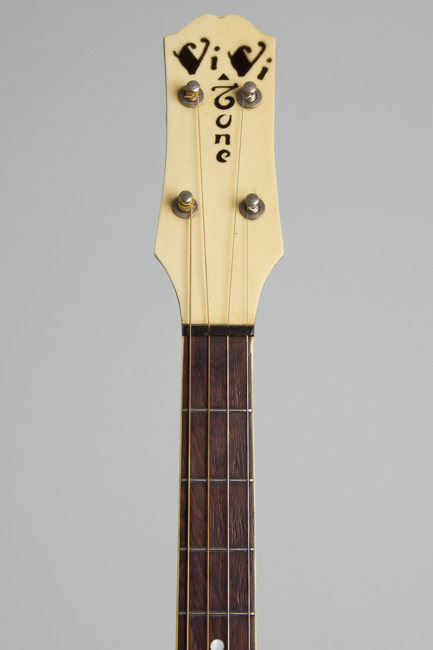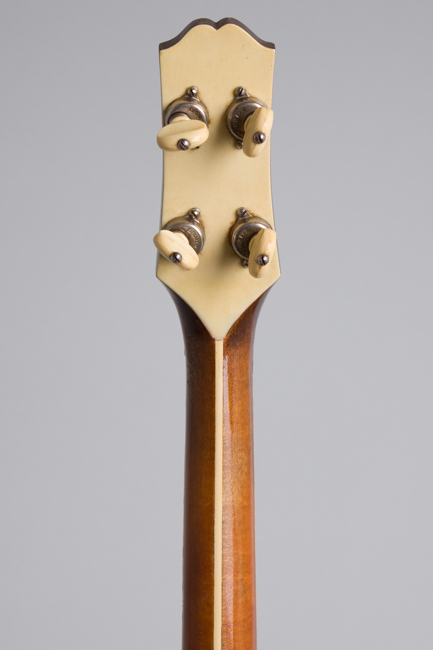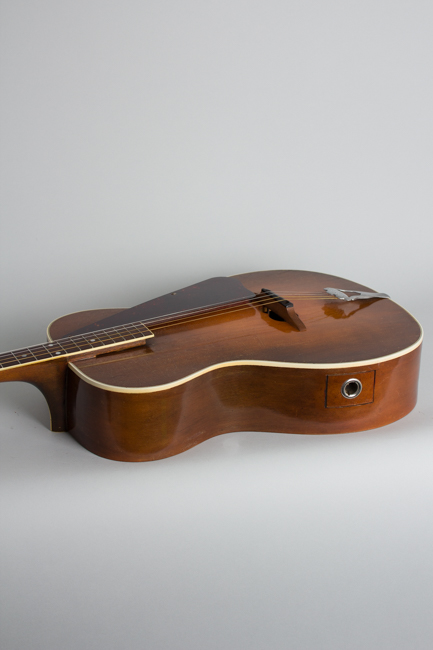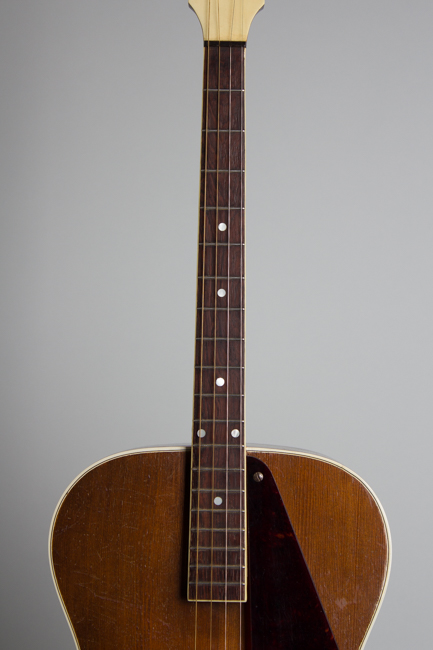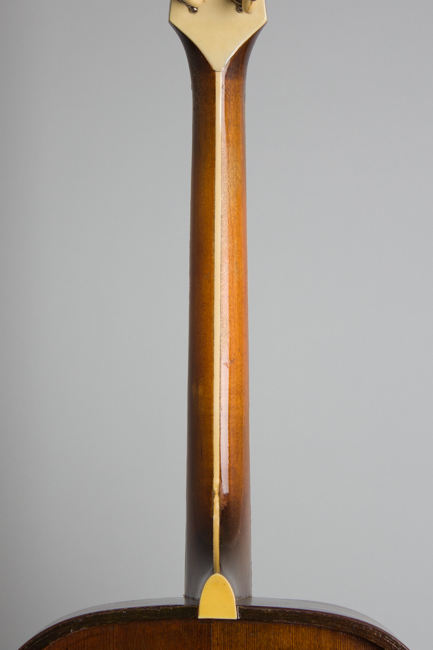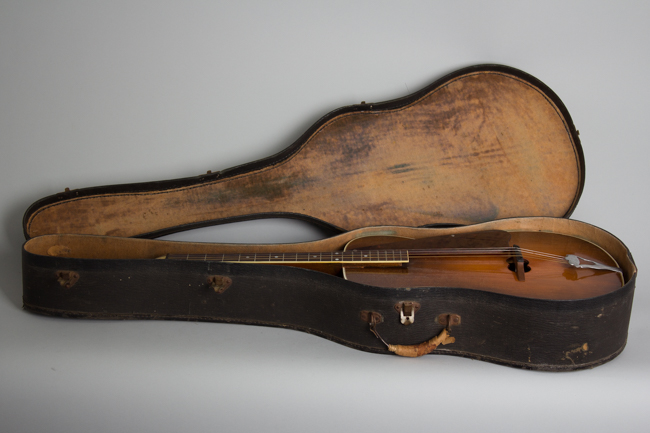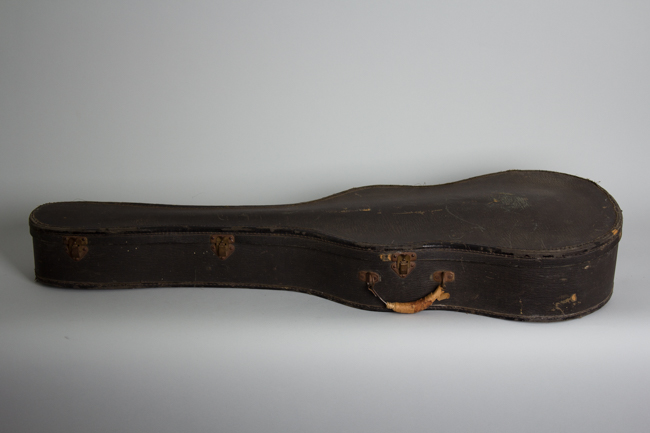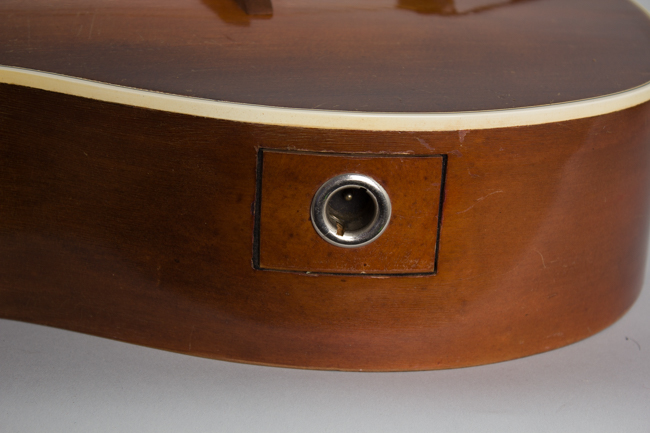Vivi-Tone Electric Tenor Guitar (1933)
This item has been sold.
Item # 10884
Prices subject to change without notice.
Vivi-Tone Electric Model Tenor Guitar (1933), made in Kalamazoo, Michigan, tobacco sunburst finish, maple rim, spruce top and back; laminated maple neck with ebony fingerboard, original black chipboard case.
We see many instruments here that fall into the rare category, even very rare, but this is one is a notable oddity. This Vivi-Tone tenor guitar is a 4-string version of the acoustic/electric "Spanish" guitars Lloyd Loar designed for his company, which themselves were produced in extremely small numbers. It is a fascinating example of Lloyd Loar and partner Lewis A. Williams' pioneering efforts in the creation of electric fretted instruments in the early 1930s. The design is utterly unique, as well as being some of the very earliest electric guitars ever made. Tenor instruments were only a VERY small part of Vivi-Tone's already limited output.
These Vivi-Tones were predated only by the lost Stromberg-Voisinet electrics that are virtually unknown, and were contemporary with the earliest Rickenbacker Electro models. Loar himself played primarily mandolin family instruments, so one can assume creating electric mandolins, tenors and Spanish guitars was a project he had more personal interest in than the Hawaiian style that was the raison d'etre for most electrics, especially Rickenbacker.
Despite its eccentric design, this is a very well-made and playable instrument with a fascinatingly engineered and complex, if somewhat primitive, pickup system. This guitar was designed to function as both an acoustic and electric instrument, unlike Vivi-Tone's contemporary plank-like solid-bodies that were purely electric.
The construction of the body is the same as Vivi-Tone's "Acousti-guitars"; by this point, the company could build either an electric or an acoustic to order from the same shell. The body is a thick-rimmed, standard-shaped affair with a sunburst finish solid spruce top and back. This radical design almost turns the guitar inside out; in the acoustic mode, the thin arched solid spruce back is the soundboard as much as the heavy spruce top. The laminated rims are very heavy to prevent any vibration, and the back is recessed into them to avoid contact with the player. The only sound hole in the top is under the substantial maple and ebony bridge -- filled in with the pickup -- while the back carries two small f-holes.
This guitar is built of high grade materials to a very high standard, certainly in a class with Gibsons of the era. The subtle hand-rubbed sunburst on the top, back, and rims is similar to 1920s Loar-era "Cremona Brown" Gibson finishes. The thin tenor neck is shaped similar to period Gibson necks with a soft "V" profile, bound ebony fingerboard, and pearl dot inlay. The narrow headstock is ivoroid veneered with a screened "Vivi-Tone" logo and four Grover tabbed banjo tuners.
The lovely sunburst top is triple-bound, and the heelcap is ivoroid. The cast metal tailpiece (which can hold 8 strings) carries a very Art Nouveau "Vivi-Tone" logo; the pickguard is heavy tortoise celluloid raised above the rim. The maple bridge has a compensated ebony cap.
The electronics are mounted in a removable drawer which slides out of the bass side of the rim, with the signal transmitted from the wooden bridge to a metal plate sensed by a pickup beneath. The cord uses an unusual twist-to-lock plug we have rarely seen on a guitar. The amplified tone is functional but low powered, and the rather inefficient and microphonic pickup would never equal the contemporary Rickenbacker unit that was its strongest competitor.
The 1930s electric revolution came too late for Vivi-Tone, the company only lasting a short time but leaving behind some of the most unusual guitars ever built, both acoustic and electric. This tenor Guitar's unplugged sound is surprisingly loud (Loar wasn't COMPLETELY out of his tree) and carries extremely well. This is one of VERY few examples of 4-string Vivi-Tones we are aware of, a fairly unique pieces from a company that specialized in the singular! Although a blind alley in guitar evolution, this is still a fascinating creation with a unique musical personality.
Overall length is 35 1/2 in. (90.2 cm.), 13 in. (33 cm.) wide at lower bout, and 3 5/8 in. (9.2 cm.) in depth, measured at side of rim. Scale length is 23 in. (584 mm.). Width of nut is 1 1/4 in. (32 mm.).
This exceptionally rare instrument remains all original, including the very unusual output jack requiring a proprietary cord; these usually got changed out decades ago! Overall it shows typical fairly minor wear including light checking, dings, dents and scrapes to the thin original finish, with some pick marks to the top and a couple of deeper case rubs on the treble side. Still, considering its age and rarity this is a very nicely preserved piece. This is a very nice playing instrument, the pickup is very inefficient by modern standards but it does work as intended. Even the original heavy chipboard case has survived, a bit battered but still fully intact. Very Good + Condition.
We see many instruments here that fall into the rare category, even very rare, but this is one is a notable oddity. This Vivi-Tone tenor guitar is a 4-string version of the acoustic/electric "Spanish" guitars Lloyd Loar designed for his company, which themselves were produced in extremely small numbers. It is a fascinating example of Lloyd Loar and partner Lewis A. Williams' pioneering efforts in the creation of electric fretted instruments in the early 1930s. The design is utterly unique, as well as being some of the very earliest electric guitars ever made. Tenor instruments were only a VERY small part of Vivi-Tone's already limited output.
These Vivi-Tones were predated only by the lost Stromberg-Voisinet electrics that are virtually unknown, and were contemporary with the earliest Rickenbacker Electro models. Loar himself played primarily mandolin family instruments, so one can assume creating electric mandolins, tenors and Spanish guitars was a project he had more personal interest in than the Hawaiian style that was the raison d'etre for most electrics, especially Rickenbacker.
Despite its eccentric design, this is a very well-made and playable instrument with a fascinatingly engineered and complex, if somewhat primitive, pickup system. This guitar was designed to function as both an acoustic and electric instrument, unlike Vivi-Tone's contemporary plank-like solid-bodies that were purely electric.
The construction of the body is the same as Vivi-Tone's "Acousti-guitars"; by this point, the company could build either an electric or an acoustic to order from the same shell. The body is a thick-rimmed, standard-shaped affair with a sunburst finish solid spruce top and back. This radical design almost turns the guitar inside out; in the acoustic mode, the thin arched solid spruce back is the soundboard as much as the heavy spruce top. The laminated rims are very heavy to prevent any vibration, and the back is recessed into them to avoid contact with the player. The only sound hole in the top is under the substantial maple and ebony bridge -- filled in with the pickup -- while the back carries two small f-holes.
This guitar is built of high grade materials to a very high standard, certainly in a class with Gibsons of the era. The subtle hand-rubbed sunburst on the top, back, and rims is similar to 1920s Loar-era "Cremona Brown" Gibson finishes. The thin tenor neck is shaped similar to period Gibson necks with a soft "V" profile, bound ebony fingerboard, and pearl dot inlay. The narrow headstock is ivoroid veneered with a screened "Vivi-Tone" logo and four Grover tabbed banjo tuners.
The lovely sunburst top is triple-bound, and the heelcap is ivoroid. The cast metal tailpiece (which can hold 8 strings) carries a very Art Nouveau "Vivi-Tone" logo; the pickguard is heavy tortoise celluloid raised above the rim. The maple bridge has a compensated ebony cap.
The electronics are mounted in a removable drawer which slides out of the bass side of the rim, with the signal transmitted from the wooden bridge to a metal plate sensed by a pickup beneath. The cord uses an unusual twist-to-lock plug we have rarely seen on a guitar. The amplified tone is functional but low powered, and the rather inefficient and microphonic pickup would never equal the contemporary Rickenbacker unit that was its strongest competitor.
The 1930s electric revolution came too late for Vivi-Tone, the company only lasting a short time but leaving behind some of the most unusual guitars ever built, both acoustic and electric. This tenor Guitar's unplugged sound is surprisingly loud (Loar wasn't COMPLETELY out of his tree) and carries extremely well. This is one of VERY few examples of 4-string Vivi-Tones we are aware of, a fairly unique pieces from a company that specialized in the singular! Although a blind alley in guitar evolution, this is still a fascinating creation with a unique musical personality.
Overall length is 35 1/2 in. (90.2 cm.), 13 in. (33 cm.) wide at lower bout, and 3 5/8 in. (9.2 cm.) in depth, measured at side of rim. Scale length is 23 in. (584 mm.). Width of nut is 1 1/4 in. (32 mm.).
This exceptionally rare instrument remains all original, including the very unusual output jack requiring a proprietary cord; these usually got changed out decades ago! Overall it shows typical fairly minor wear including light checking, dings, dents and scrapes to the thin original finish, with some pick marks to the top and a couple of deeper case rubs on the treble side. Still, considering its age and rarity this is a very nicely preserved piece. This is a very nice playing instrument, the pickup is very inefficient by modern standards but it does work as intended. Even the original heavy chipboard case has survived, a bit battered but still fully intact. Very Good + Condition.
